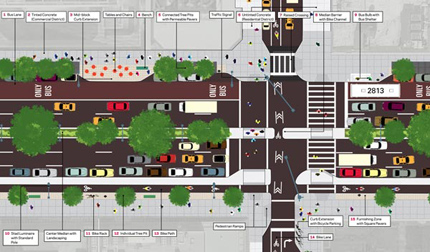
NYC Street Design Manual's illustration of major street features. Design: Pure+Applied
About a month ago I received a package in the mail from my co-author Andres Duany. It was the New York City Street Design Manual, with a cover letter imploring me to look at the paper. “It feels just right — so green! We need to use the same paper for our manual.”
Indeed, the slightly rough, porous paper is one of many details, tactile and otherwise, that add up to the just-right feeling of this timely and valuable book (if one can call a tabbed loose-leaf binder a book.) Every aspect of this product feels positively 21st century, except perhaps its unerringly even-handed treatment of the broad range of solutions it offers — solutions that span the spectrum from the mundane to the revolutionary.
Andres need not have sent me the manual, as I already had a copy, received from the City of New York’s on-line shop after a long wait. It came just in time to help me with comprehensive pro-walkability street redesign efforts that I am working on for Oklahoma City and Davenport, Iowa. Just how much it was able to help me, and where it fell short, will be one subject of this essay.
But first, let’s dispense with the obligatory assessment: Do you need to buy this $35 book? Yes, if you are involved in any way in the design of city streets. Yes, also, if you can plop it on the lap of someone who is. Since this collection of best practices is put forward as the recommended policy of our nation’s biggest city, its potential clout makes up for any flaws or limitations in its contents. Of course, its only weakness as a political tool stems necessarily from the same source: I can already hear my Midwestern clients complaining that they don’t want to become New York. But we know that deep down, just a little bit, most of them would like to share some of the magic of America’s most sustainable city.
The book is clearly organized in four sections: Using the Manual, Geometry, Materials and Lighting. It is written well and simply, and illustrated with both drawings and photographs from New York and beyond. Where a recommended practice is not yet built locally, a peripatetic photographer has spanned the globe (or the internet), so we see rain gardens from Portland, integral curbs from Miami Beach and imprinted asphalt from Taranto, Italy.

For example, take my absolute favorite sentence in the manual:
“To reduce pedestrian crossing distances and reduce impermeable, heat-absorbing coverage, the paved roadway of all streets should be designed to be the minimum width — and have the minimum number of lanes — that safely and cost-effectively allow for the desired operations of motor vehicles, buses, and bicyclists.”
This is the sort of sentence that brings tears to the eyes of urbanists and environmentalists everywhere. It cannot be faulted. But read the last part again. Who is going to determine what the desired operations of motor vehicles are, and when they call for more or wider lanes? That is the sort of caveat that has been shown to kill walkability from coast to coast, unless precise measures are put in place to ensure the slower driving speeds that the manual advocates.
A 10-foot-wide driving lane, the historical standard, induces motorists to drive at speeds that are safe for nearby pedestrians. Many city streets, reamed out by Neanderthal postwar traffic engineers, have lanes that are 12 feet wide or more. These highway-size lanes induce highway speeds. In most of the cities in which I work, I have to fight to reduce 70 MPH lanes to 30 MPH lanes, and I am always searching for my holy grail, the official government document that is going to make my job easy. I’m still looking. Why can’t a manual that specifies the exact width of six types of bike lanes discuss the size of a car lane with any precision?
The other frustration brought on by this otherwise remarkable manual comes from its somewhat schizophrenic treatment of sustainability. While the text advocates unfailingly for planted and high-albedo (reflective) surfaces, stormwater-absorbing roadbeds and low-energy lighting, these solutions are then offered as few out of many, typically at the end of a longer list of less sustainable alternatives. One needs to flip through a dozen conventional streetlights before coming across two low-carbon LED standards. Why does New York have to approach LED as a “pilot” project, when Ann Arbor has already re-outfitted its whole downtown?
These criticisms point less to flaws in this manual than to the need for a sister document, not a handbook but an ordinance, that mandates the use of its more sustainable and pedestrian-friendly solutions. The Street Design Manual is a necessary but not sufficient document, an important and exemplary first step toward the humanizing and greening of the public spaces of New York. Its very existence is a bit of a miracle. But whether it ultimately achieves the goals of its creators will depend on the courage and political skill of city leaders, who will need to overcome the old-school thinking and departmental inertia to which even New York City is not immune.
